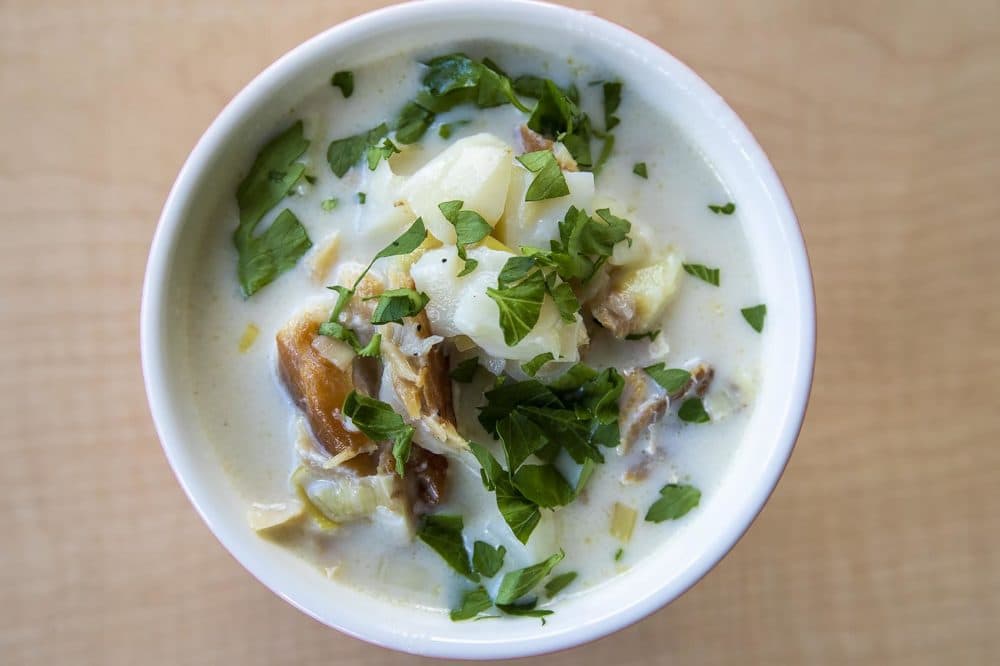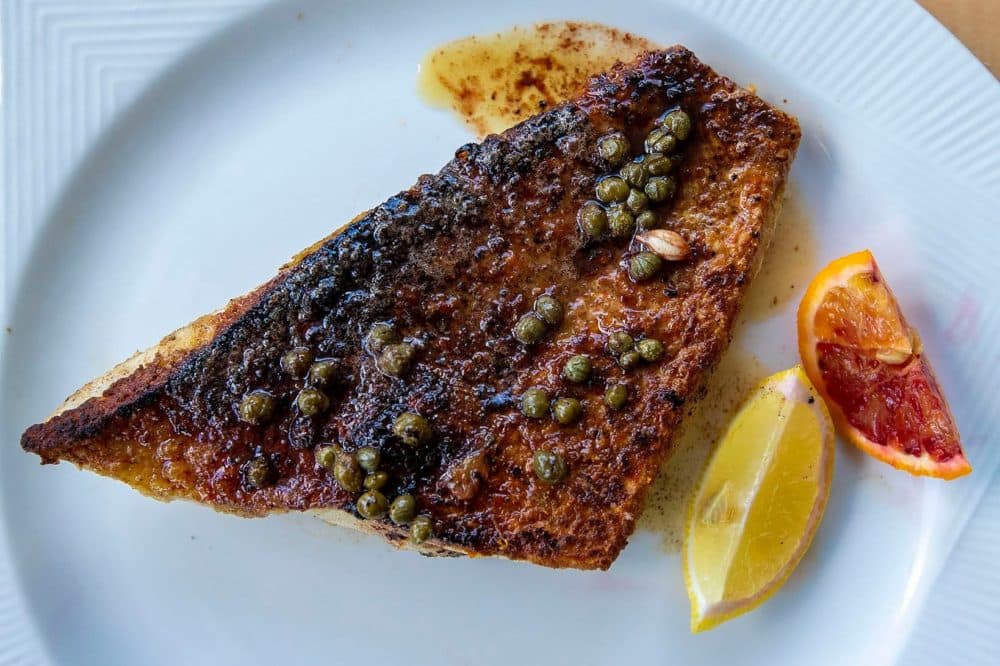Most cooks think about eating fish and seafood during the spring, summer and early fall months. But there’s lots of good fish and seafood available all winter long, often in places you’d least expect to look.
I called “seafood evangelist” Barton Seaver, the author of many excellent books including “The Joy of Seafood” and “American Seafood," a massive, comprehensive catalog of American seafood.
Seaver talked about many regional types of fish that are worth seeking out in winter, including:
- West Coast Dungeness crab and rockfish
- East Coast harbor pollock, skate, monkfish, scallops and smelts
- Southern mullet and mackerel from the Gulf of Mexico and porgy from south of the Carolinas
Seaver then discussed frozen seafood. Yes, I said frozen seafood. And we’re not talking about fish sticks here!
The technological advances in freezing fish and seafood have been enormous in past years, he says. Many fishermen and women are investing in at-sea processing equipment so they can freeze fish right after it is harvested. The fish is frozen at lower temperatures which, he says, can “lead to lower costs, lower waste and fish that is ultimately cheaper to transport.”
I recently tried cooking with frozen rockfish from Beaver Street Fisheries in Jacksonville, Florida. They sell a variety of frozen fish, and I was shocked to find the frozen fillets to be every bit as good as fresh ones, if not better. I then went to my local fish store and bought two frozen red snapper fillets and was thrilled with the quality. Frozen fish is no longer second rate.
Seaver then went on to say, “Winter lends itself to revisiting preserved seafood, like Finnan haddie, smoked salmon, canned tuna, anchovies and sardines.”
Frozen fish, smoked fish, canned fish and locally sourced winter fish provide a whole lot of choice for winter eating. Give these three recipes a try to get you started. And always look for sustainably raised fish and seafood. For more information about sustainability, check out the Gulf of Maine Research Institute and Seafood Watch.
Scottish-Style Smoked Haddock and Leek Chowder (Cullen Skink)

Smoked haddock, also called Finnan haddie, is a lightly smoked fillet of haddock. It is often found in the freezer section of many fish stores. I use it here to make this rich chowder, ideal for a cold winter day.
This recipe is from my book Soup Swap (Chronicle Books). My friends Rebecca Mitchell and Ben Harris served this chowder at a Soup Supper and we all went nuts for the smoky, sweet, delicate flavor. They found the original recipe in a British magazine called Country Living. This is my adaptation. Serve this rich chowder piping hot, with warm crusty bread or biscuits.
Serves 8
Ingredients
- 2 1/2 cups of milk
- 1 pound smoked haddock, also called Finnan haddie
- 1 bay leaf
- Few sprigs fresh parsley
- 1 small onion, peeled and quartered
- Grinding black pepper
- 1 tablespoon olive oil
- 1 tablespoon butter
- 2 medium leeks, dark green section discarded, and the pale green and white sections cut lengthwise and then very thinly sliced
- 2 tablespoons flour
- 2 cups fish stock, (look in the freezer section at your local fish store)
- 1 pound potatoes, peeled and diced
- Salt to taste
- 1/2 cup, plus 2 tablespoons heavy cream
- 2 tablespoons fresh chives, minced
Instructions
- In a medium pot mix the milk, haddock, bay leaf, parsley, onion and pepper. Bring to a simmer over low heat. Remove from the heat and let sit 15 minutes. The smoked fish and the aromatics will steep and flavor the milk. When cool enough to handle, remove the haddock and flake the meat, removing the skin or any bones; reserve.
- In a large pot heat the oil and butter over low heat. Add the leeks, salt and pepper and stir. Cover the pot and sweat the leek for 8 minutes, stirring once or twice. Stir in the flour and cook for a minute. Strain the milk over the leeks and flour, stirring well. Discard the aromatics from the milk. Add the fish stock and simmer for 2 minutes. Add the potatoes and cook over low heat for 15 minutes or until the potatoes are almost tender. Add the reserved haddock and the cream and heat over very low heat for 10 minutes. Season to taste with salt and pepper. Sprinkle with the chives just before serving.
Broccoli “Caesar” Style with Anchovies and Miso Dressing
As far as I’m concerned anchovies — small, oily fish found in the Mediterranean — are the single greatest canned or jarred food in the world. They’re salty, with a loud, pronounced flavor that adds a wonderful umami flavor to all foods. Anchovies are also rich in omega-3 fatty acids, and an excellent source of protein. Use them in salads, to top a pizza, melted down into a tomato sauce with capers, pitted olives, basil and hot pepper flakes (to serve on top of pasta or fish) or serve them on lightly toasted buttered bread. White anchovies are slightly milder and can be easily substituted.
The inspiration for this simple salad came from a dish at Fox & the Knife in South Boston. Chef Karen Akunowicz’s Broccoli Alla Grillia “Caesar” features grilled broccoli in a rich anchovy dressing. My adaptation uses thinly sliced broccoli sautéed in a cast iron skillet over high heat with olive oil. You can make the dressing a full day ahead of time, but don’t toss it until just before you’re ready to serve the dish.
Serve as a salad or first course with breadsticks or warm, crusty bread. The anchovy-miso dressing is also delicious on mixed greens, potatoes, or grilled fish.
Serves 2 to 4.
Ingredients
The Broccoli:
- 1 pound broccoli, thinly sliced including the stems
- 2 tablespoons olive oil
- Salt and freshly ground black pepper
The Anchovy-Miso Dressing:
- 1 tablespoon white miso
- 2 to 3 anchovy filets (depending on how much you love anchovies), plus 2 to 4 anchovy filets for topping
- 2 tablespoons anchovy oil (from the can or jar)
- 2 tablespoons olive oil
- 3 tablespoons lemon juice, from 1 small lemon
- Freshly ground pepper
- 1/4 cup grated Parmesan cheese
Instructions
- Heat a large (preferably cast iron) skillet over moderately high heat. Add the olive oil and cook the broccoli, turning it from side to side for about 10 minutes, or until browned and just tender—not limp. Remove and place on a serving platter.
- To make the sauce: place all the ingredients in a blender or food processor and whirl. Taste for seasoning. Do not add salt as the anchovies are quite salty.
- Just before serving, gently toss the broccoli with the sauce and place 2 to 4 anchovy filets crisscrossed into an “X” on top of the salad.
Pan Sautéed Red Snapper with Blood Orange, Caper and Brown Butter Sauce

I found gorgeous frozen filets of red snapper in my local fish store. Snapper is a wild-caught American fish that's sustainably managed. It's a beautiful, rosy-skinned white fish with a firm texture that comes from the Gulf of Mexico and south of the Carolinas.
This simple fish sauté can be made with any firm whitefish, like sole, flounder, rockfish, dogfish, etc.
Serves 2.
Ingredients
- 1/2 cup flour
- Salt and pepper
- 1 pound frozen red snapper, or other firm white fish
- 2 blood oranges, or tangerines
- About 2 to 3 tablespoons butter
- 1 tablespoon olive oil
- About 2 to 3 tablespoons capers, drained
Instructions
- Place the flour on a plate and season well with salt and pepper. Lightly dredge the snapper fillets in the seasoned flour.
- Remove the zest from the orange and set aside. Juice one orange and set aside and cut the remaining orange in small wedges or cubes.
- In a large, heavy (preferably cast iron) skillet, heat 1 tablespoon of the butter and the oil over moderately high heat. When the butter is foaming add the fish and cook skin side down for about 3 to 4 minutes, depending on the thickness of the filet. The skin should be golden brown. Gently flip the fish over. Sauté another 3 minutes.
- Sprinkle the zest from the blood oranges over the fish flesh and cook another minute. Add the orange juice and the remaining butter to the skillet and let it sizzle until a golden brown. Add the capers, season with pepper. Plate the fish and spoon the sauce on top. Garnish with the blood orange wedges.
"fish" - Google News
January 22, 2020 at 11:34PM
https://ift.tt/2NMdfUI
Smoked, Frozen Or Canned: Chef Kathy Gunst Dives Into Fish Recipes For Winter - Here And Now
"fish" - Google News
https://ift.tt/35JkYuc
Shoes Man Tutorial
Pos News Update
Meme Update
Korean Entertainment News
Japan News Update
No comments:
Post a Comment